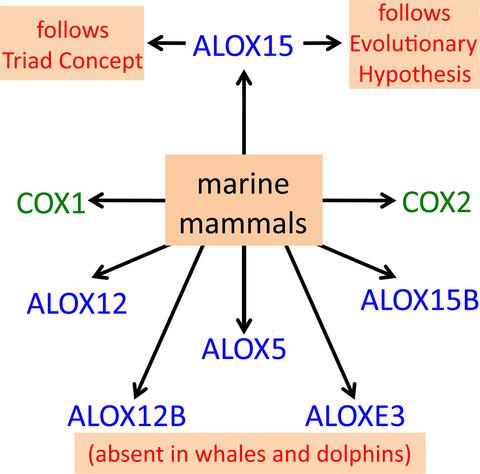Our official English website, www.x-mol.net, welcomes your
feedback! (Note: you will need to create a separate account there.)
Eicosanoid biosynthesis in marine mammals
The FEBS Journal ( IF 5.5 ) Pub Date : 2020-07-05 , DOI: 10.1111/febs.15469 Florian Reisch 1 , Kumar Reddy Kakularam 1 , Sabine Stehling 1 , Dagmar Heydeck 1 , Hartmut Kuhn 1
The FEBS Journal ( IF 5.5 ) Pub Date : 2020-07-05 , DOI: 10.1111/febs.15469 Florian Reisch 1 , Kumar Reddy Kakularam 1 , Sabine Stehling 1 , Dagmar Heydeck 1 , Hartmut Kuhn 1
Affiliation

|
After 300 million years of evolution, the first land‐living mammals reentered the marine environment some 50 million years ago. The driving forces for this dramatic lifestyle change are still a matter of discussion but the struggle for food resources and the opportunity to escape predators probably contributed. Reentering the oceans requires metabolic adaption putting evolutionary pressure on a number of genes. To explore whether eicosanoid signaling has been part of this adaptive response, we first explored whether the genomes of marine mammals involve functional genes encoding for key enzymes of eicosanoid biosynthesis. Cyclooxygenase (COX) and lipoxygenase (ALOX) genes are present in the genome of all marine mammals tested. Interestingly, ALOX12B, which has been implicated in skin development of land‐living mammals, is lacking in whales and dolphins and genes encoding for its sister enzyme (ALOXE3) involve premature stop codons and/or frameshifting point mutations, which interrupt the open reading frames. ALOX15 orthologs have been detected in all marine mammals, and the recombinant enzymes exhibit similar catalytic properties as those of land‐living species. All marine mammals express arachidonic acid 12‐lipoxygenating ALOX15 orthologs, and these data are consistent with the Evolutionary Hypothesis of ALOX15 specificity. These enzymes exhibit membrane oxygenase activity and introduction of big amino acids at the triad positions altered the reaction specificity in favor of arachidonic acid 15‐lipoxygenation. Thus, the ALOX15 orthologs of marine mammals follow the Triad concept explaining their catalytic specificity.
中文翻译:

海洋哺乳动物中类花生酸的生物合成
经过3亿年的进化,大约5000万年前,第一批陆地上的哺乳动物重新进入了海洋环境。这种生活方式发生巨大变化的驱动力仍然是讨论的问题,但是食物资源的挣扎和逃避捕食者的机会可能有所贡献。重新进入海洋需要新陈代谢适应,这给许多基因带来了进化压力。为了探讨类花生酸信号传导是否已成为这种适应性反应的一部分,我们首先探讨了海洋哺乳动物的基因组是否涉及编码类花生酸生物合成关键酶的功能基因。在所有测试的海洋哺乳动物的基因组中都存在环氧合酶(COX)和脂氧合酶(ALOX)基因。有趣的是,ALOX12B与陆地哺乳动物的皮肤发育有关,鲸鱼和海豚缺乏,其姊妹酶(ALOXE3)的编码基因涉及过早的终止密码子和/或移码点突变,这些突变会打断开放阅读框。在所有海洋哺乳动物中都检测到了ALOX15直向同源物,重组酶表现出与陆地生物相似的催化特性。所有海洋哺乳动物都表达花生四烯酸12-脂氧化ALOX15直系同源物,这些数据与ALOX15特异性的进化假说是一致的。这些酶表现出膜加氧酶活性,并且在三联体位置引入大氨基酸改变了反应特异性,有利于花生四烯酸15-脂氧合。因此,海洋哺乳动物的ALOX15直系同源基因遵循Triad概念,解释了其催化特异性。
更新日期:2020-07-05
中文翻译:

海洋哺乳动物中类花生酸的生物合成
经过3亿年的进化,大约5000万年前,第一批陆地上的哺乳动物重新进入了海洋环境。这种生活方式发生巨大变化的驱动力仍然是讨论的问题,但是食物资源的挣扎和逃避捕食者的机会可能有所贡献。重新进入海洋需要新陈代谢适应,这给许多基因带来了进化压力。为了探讨类花生酸信号传导是否已成为这种适应性反应的一部分,我们首先探讨了海洋哺乳动物的基因组是否涉及编码类花生酸生物合成关键酶的功能基因。在所有测试的海洋哺乳动物的基因组中都存在环氧合酶(COX)和脂氧合酶(ALOX)基因。有趣的是,ALOX12B与陆地哺乳动物的皮肤发育有关,鲸鱼和海豚缺乏,其姊妹酶(ALOXE3)的编码基因涉及过早的终止密码子和/或移码点突变,这些突变会打断开放阅读框。在所有海洋哺乳动物中都检测到了ALOX15直向同源物,重组酶表现出与陆地生物相似的催化特性。所有海洋哺乳动物都表达花生四烯酸12-脂氧化ALOX15直系同源物,这些数据与ALOX15特异性的进化假说是一致的。这些酶表现出膜加氧酶活性,并且在三联体位置引入大氨基酸改变了反应特异性,有利于花生四烯酸15-脂氧合。因此,海洋哺乳动物的ALOX15直系同源基因遵循Triad概念,解释了其催化特异性。











































 京公网安备 11010802027423号
京公网安备 11010802027423号